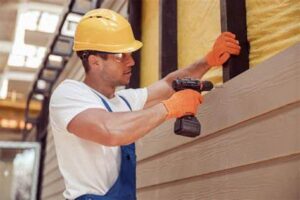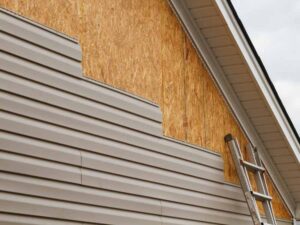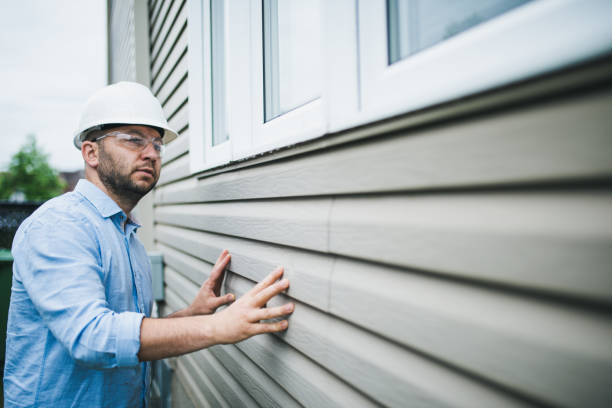Selecting the right siding for your home is not just about aesthetics but also about protecting your investment and enhancing functionality. This section delves into what siding is, its significance, and the essential factors to consider to help you choose the most suitable siding for your house.
What is Siding and Why is it Important?

Siding acts as the protective outer layer that shields your home from various environmental elements. It is available in different materials such as vinyl siding, fiber cement, wood siding, and metal siding, each offering specific advantages. Siding not only protects the home against weather conditions like wind, rain, and sun but also contributes to the structural integrity of the building.
The significance of choosing the right siding extends to its impact on a home’s energy efficiency and overall aesthetic value. For example, installing fiber cement siding or stone veneer can dramatically change the appearance of your home and potentially increase its market value. Good siding acts as insulation, keeping the home warmer in winter and cooler in summer, which can lead to significant energy savings.
Factors to Consider When Choosing Siding
Choosing the right siding for your home is important. Siding affects the appearance and protection of your house. When making a decision, several factors should be considered. These factors include material type, cost, durability, maintenance, energy efficiency, and climate suitability. Understanding these elements will help you make an informed choice. Your choice will impact your home’s look, longevity, and value.
Climate and Weather Conditions
It’s essential to choose siding materials that can withstand the local climate. For example, fiber cement siding and engineered wood siding are known for their resilience in various weather conditions, whereas vinyl siding might warp or fade in extreme temperatures.
Budget and Cost
The cost of siding materials can vary significantly, from relatively inexpensive options like vinyl siding, which costs less per square foot, to more luxurious choices such as stone veneer siding and cedar siding. It’s important to consider both initial expenses and long-term maintenance costs. Options like engineered wood may offer a balance between cost and appearance.
Aesthetic Preferences and Design Options
The appearance of your siding can drastically alter the curb appeal of your home. Materials like cedar siding and brick siding provide distinct looks and can complement various architectural styles. Stone veneer and metal siding offer unique textures and finishes that might appeal to specific design tastes.
Durability and Lifespan Expectations
Longevity is a critical consideration. Materials like stone veneer and brick siding are durable and can last decades with minimal care. Conversely, materials like cedar siding may require more frequent maintenance to retain their aesthetic appeal and structural integrity.
Energy Efficiency and Sustainability
Insulated vinyl siding and fiber cement are popular for their energy-efficient properties, which can significantly reduce heating and cooling costs. Many homeowners are also considering the environmental impact of their siding choices, opting for sustainable materials that offer both performance and eco-friendly benefits.
Maintenance Requirements
Maintenance is a key factor in the long-term satisfaction and cost-effectiveness of siding. Vinyl siding and fiber cement usually require less upkeep than wood siding, which might need periodic staining and pest treatment to maintain its condition.
Siding Materials

Exploring different siding materials helps homeowners make an informed choice based on durability, aesthetics, and maintenance requirements. This section discusses three popular types of siding—vinyl, wood, and fiber cement—each offering unique benefits and characteristics.
Vinyl Siding: Durable and Affordable
Vinyl siding is a top siding choice among many homeowners due to its affordability and minimal maintenance needs. It is made primarily from plastic siding materials and is known for its durability, capable of withstanding harsh weather conditions without fading or cracking. Available in a multitude of colors and styles, such as horizontal and vertical panels, vinyl siding offers flexibility to meet various architectural styles. Its cost-effectiveness per square foot makes it an appealing option for those looking to upgrade their home’s exterior without breaking the bank.
Wood Siding: Classic and Natural
Wood siding, often referred to as real wood siding, provides a classic and natural look that many homeowners desire. This type of exterior siding is available in several types, including popular choices like cedar, pine, and spruce. Each variety brings a unique aesthetic and texture to a home’s facade. However, wood siding demands regular maintenance, including staining and sealing, to protect against damage and rot. Despite the maintenance involved, its traditional appeal and the warmth it adds to the exterior make it a perennial favorite.
Fiber Cement Siding: Robust and Long-Lasting
Fiber cement siding is a composite material that offers robustness and longevity, making it a superior choice for exterior siding options. This siding is crafted from a mix of Portland cement, sand, and wood fibers, providing a fire-resistant and pest-resistant surface. Fiber cement siding is particularly noted for its resistance to rotting, warping, and fading. Its durability and low maintenance requirements make it a practical choice for homeowners looking for a long-lasting solution. Fiber cement, often associated with brands like James Hardie siding, is favored for its ability to mimic other materials like wood and stone while offering enhanced durability and fire resistance.
Stone Veneer Siding: Timeless and Elegant
Stone veneer siding provides the natural beauty and elegance of real stone but at a more accessible price point, making it one of the best house siding options for those seeking a luxurious exterior without the hefty cost. This siding is crafted from thin layers of stone that are attached to a durable backing material, ensuring stability and longevity. Stone veneer siding enhances the aesthetic appeal of a home, offering the look of natural stone with the benefits of modern engineering. It stands out for its ability to blend into nearly any environment, enhancing the home’s natural beauty without all the maintenance required by traditional stone.
Metal Siding: Sleek and Low Maintenance
Metal siding, utilized in various siding styles, is crafted from robust materials like aluminum, steel, and copper, known for their durability and resistance to high winds, weathering, and pests. Unlike wood, metal siding requires very little maintenance, making it a practical option for many homeowners. This type of siding is celebrated for its sleek, modern appearance, that can significantly enhance the exterior of any contemporary home. With its excellent energy efficiency and weather-resistant properties, metal siding stands as an ideal choice for those looking for energy-efficient siding with low upkeep.
Cost and Budgeting
Understanding the financial aspects of choosing and installing siding is crucial. This section will guide you through the costs associated with different siding materials and provide strategies for effective budgeting for your siding project.
Siding Cost: Factors to Consider
Several factors influence the cost of siding, making it important to evaluate each before making a decision:
Material cost per square foot: The price can vary significantly, from economical options like vinyl siding to more premium choices like fiber cement siding or brick siding.
Installation cost: This can differ based on the complexity of the siding material. For example, fiber cement and engineered wood siding might require more specialized labor compared to vinyl siding.
Maintenance and repair costs: Materials like wood siding require more upkeep compared to other siding materials, which can affect long-term expenses.
Lifespan and durability: Investing in durable materials like brick siding or fiber cement may offer greater longevity, potentially reducing the frequency and cost of replacements.
Budgeting for Siding Installation
Proper budgeting is key to managing the financial impact of new siding:
Determine your budget and prioritize your needs: Start by defining how much you can spend and what you expect from your siding in terms of appearance, durability, and maintenance.
Consider the cost of materials, installation, and maintenance: Evaluate the total expenditure for materials like fiber cement siding or vinyl siding per square foot, including the cost of installation and potential future maintenance.
Plan for contingencies and unexpected expenses: Always allocate a portion of your budget for unforeseen costs to ensure that your siding project does not halt mid-way due to financial constraints.
Siding Characteristics
Choosing the right siding involves more than just the cost; aesthetics, durability, and energy efficiency also play critical roles. This section will explore how these factors can influence your choice of siding and ensure you select a product that meets both your practical needs and aesthetic preferences.
Aesthetics and Design Options
Siding materials come in a variety of design options, each offering different colors, textures, and patterns that can dramatically alter the appearance of your home. When selecting new siding, it’s crucial to consider how the aesthetics of the siding material will complement the style and architecture of your home. Whether it’s the rustic charm of stone siding, the smooth, modern look of stucco siding, or the classic appeal of brick veneer, each material can enhance your home’s curb appeal in unique ways.
Durability and Lifespan Expectations
The durability and expected lifespan of siding materials can vary greatly. Materials like steel siding and aluminum siding are known for their strength and can last 40 to 50 years or more with proper maintenance, while other materials may have shorter lifespans. When making your siding choice, consider how long each material is expected to last and how well it can withstand the local climate conditions. This consideration will ensure that your investment is both durable and cost-effective over time.
Energy Efficiency and Sustainability
The impact of siding on a home’s energy efficiency and sustainability is significant. Materials such as stone siding and stucco siding can provide excellent thermal performance, which helps in maintaining a consistent indoor temperature and reducing heating and cooling costs. When evaluating siding options, look at the R-value and overall insulating properties of each siding material. Choosing a siding that offers high energy efficiency not only contributes to a more sustainable home but also results in long-term savings on energy bills.

Installation and Maintenance
Proper installation and ongoing maintenance are key to maximizing the lifespan and effectiveness of your siding. This section covers the essential steps in the installation process and provides tips for maintaining different types of siding materials.
Siding Installation Process
The installation of new siding involves several critical steps: preparing the underlying surface, correctly installing the siding panels, and ensuring that the edges and corners are finished neatly. Given the complexity and the importance of correct installation to ensure energy efficiency and durability, it is advisable to hire a professional. Professionals ensure that everything from the removal of old siding to the precise placement of fire-resistant materials and lap siding is handled with expertise, thus safeguarding your investment.
Climate and Weather Considerations
Selecting the right siding involves understanding how different materials will perform under specific climatic conditions. This section covers the importance of knowing your local climate and how various weather patterns affect siding choices.
Understanding Your Local Climate
The performance and lifespan of siding materials are heavily influenced by climate and weather conditions. For instance, materials like vinyl fiber cement and those containing cellulose fibers may resist rot and maintain structural integrity even in wet climates. Knowing your local climate helps in selecting a siding product that not only enhances the home’s architectural style but also withstands local environmental challenges. This understanding ensures that your chosen house siding options meet both aesthetic desires and practical needs, from fire resistance to maintenance requirements.
How Weather Affects Siding Materials
Extreme temperatures and humidity levels can severely impact the longevity and appearance of siding. For example, materials like vinyl and metal siding are engineered for minimal upkeep and enhanced weather resistance, making them suitable for areas experiencing harsh weather conditions. On the other hand, traditional materials such as wood may require more maintenance and can be susceptible to damage in similar conditions. Choosing a siding that aligns with the specific weather patterns of your area can help maximize the insulating value and curb appeal of your home, ensuring that the material costs and installation efforts are worthwhile investments.
Maintenance Tips for Different Siding Materials
Maintaining your siding effectively requires regular cleaning and routine inspections to prevent potential issues such as moisture accumulation or wear and tear. The specific maintenance requirements vary depending on the siding material:
Natural Wood and Real Wood: These materials may need more frequent maintenance due to their susceptibility to weather and pest damage. Regular staining and sealing can protect wood fibers and preserve the beauty and integrity of the siding.
Durable Materials like Vinyl and Metal: These siding options are popular due to their low maintenance needs. However, they still benefit from occasional cleaning to remove dirt and debris and inspections to check for any damage from environmental exposure.
Lap Siding and Other Siding Products: Regardless of the material, ensure that joints and overlaps are checked regularly to avoid water ingress, which can lead to damage over time.
Choosing the Best Siding
Selecting the best siding involves careful consideration of your home’s specific needs and conditions. This section will guide you through assessing your home’s requirements and consulting with professionals to make an informed decision.
Considering Your Home’s Unique Needs
To choose the right siding for your home, consider various factors that affect performance and appearance:
Climate
The choice of siding material should be appropriate for your local climate. For example, fiber cement siding and brick siding are excellent for wet climates due to their moisture-resistant properties.
Architecture and Style
The siding should complement your home’s architectural style. Traditional homes might look best with natural wood or real wood siding, while modern homes could benefit from the sleek look of aluminum siding or steel siding.
Budget
Evaluate the cost of different materials per square foot, including potential long-term maintenance costs. Vinyl siding and engineered wood siding often provide a balance between cost and quality, offering durability with less maintenance.
Expert Advice for Selecting the Right Siding
Consulting with a professional can significantly aid in making the best siding choice for your home:
Professional Guidance: Experts like those familiar with James Hardie products or Hardie board can provide insights into which materials are most durable and low maintenance for your particular situation.
Consider Durability and Maintenance: A professional can help assess how different siding materials—whether it’s lap siding, stone siding, or stucco siding—will hold up over time and what kind of maintenance each will require.
Energy Efficiency: Specialists can also advise on the energy efficiency of various siding options, helping you choose materials like fiber cement or brick veneer that will help keep your home comfortable and reduce energy costs.
Final Tips for a Durable and Attractive Exterior
To ensure a durable and attractive exterior, choose the right siding material that meets your home’s unique needs, considering factors like climate compatibility and aesthetic appeal. Hiring a professional for installation can guarantee a correct and secure fit, maximizing the durability and effectiveness of materials like fiber cement siding or engineered wood siding. Regular maintenance is essential to extend the lifespan of your siding, whether it’s simple cleaning or more involved repairs, ensuring your home remains beautiful and well-protected for years to come.
If you’re ready to upgrade your home’s exterior, consider Plymouth Siding and Roofing for your siding needs. Contact us today to find out how we can enhance the beauty and durability of your home.
